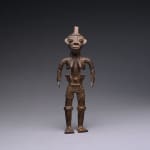Dan Brass Sculpture of a Woman, 20th Century CE
Brass
height 21.6 cm
height 8 1/2 in
height 8 1/2 in
PF.6057
Further images
Like the gold weights of the Akan peoples and the heddle pulleys of the Baule and Senufo tribes, the bronze figures of the Dan are considered to be the exceptional...
Like the gold weights of the Akan peoples and the heddle pulleys of the Baule and Senufo tribes, the bronze figures of the Dan are considered to be the exceptional case in the corpus of African art: art objects created for art’s sake. Void of any religious significance or ceremonial function, these realistically crafted sculptures were used by chieftains as purely decorative objects. The chieftain took pleasure in them as they are, appreciating the extraordinary beauty of the objects and the inherent skills of the craftsmanship.
This sculpture of a mother with a baby clinging to her back bears the stylistic signatures of Dan figurative art including the bulbous limbs, planar feet and hands, and the almond-shaped eyes. Her head is crowned by an elaborate crested hairstyle that enhances the sense of her physical beauty. Her outstanding beauty is also implied by the decorative bands she wears just above her knees, reflective of her wealth and rank in society. The child on her back is a clear symbol of her fecundity. Her large sagging breasts are exaggerated in order to enhance further her fertility. Such a splendid masterpiece of sculpture needs no ceremonial or religious purpose to achieve its power. The force of this artwork is the art itself and the hand of the sculptor. Originally, this work was coveted as an object of beauty by chieftains of the Dan tribe. Today, we appreciate this same striking beauty much as the chieftain would have almost a century ago.
This sculpture of a mother with a baby clinging to her back bears the stylistic signatures of Dan figurative art including the bulbous limbs, planar feet and hands, and the almond-shaped eyes. Her head is crowned by an elaborate crested hairstyle that enhances the sense of her physical beauty. Her outstanding beauty is also implied by the decorative bands she wears just above her knees, reflective of her wealth and rank in society. The child on her back is a clear symbol of her fecundity. Her large sagging breasts are exaggerated in order to enhance further her fertility. Such a splendid masterpiece of sculpture needs no ceremonial or religious purpose to achieve its power. The force of this artwork is the art itself and the hand of the sculptor. Originally, this work was coveted as an object of beauty by chieftains of the Dan tribe. Today, we appreciate this same striking beauty much as the chieftain would have almost a century ago.









